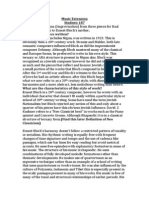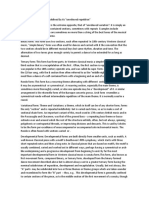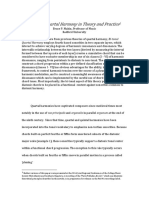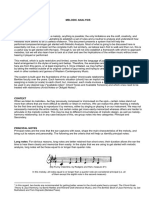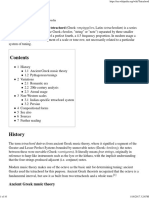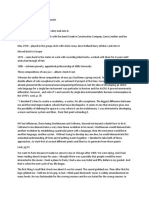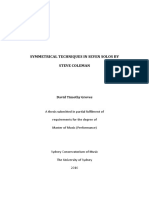Augmented Scale Theory Paper
Augmented Scale Theory Paper
Uploaded by
mikealexmacCopyright:
Available Formats
Augmented Scale Theory Paper
Augmented Scale Theory Paper
Uploaded by
mikealexmacOriginal Description:
Copyright
Available Formats
Share this document
Did you find this document useful?
Is this content inappropriate?
Copyright:
Available Formats
Augmented Scale Theory Paper
Augmented Scale Theory Paper
Uploaded by
mikealexmacCopyright:
Available Formats
Jazz Line and Augmented Scale Theory: Using Intervallic Sets to Unite Three- and Four-Tonic Systems by Javier
Arau June 14, 2008 INTRODUCTION Contemporary jazz music is experiencing a renaissance of sorts, as the tonal language of early jazz and bebop, deeply rooted in Western harmony and still an influential and governing force in current music, increasingly mingles with a chromatic and atonal palette. Rather than embracing a free-for-all, chromatic and outside approach introduced to jazz decades ago, many musicians today increasingly seem to be interested in grounding atonal chromaticism within a tonal system. Current trends in chromaticism seem to have been influenced considerably by a philosophy, espoused by artists such as David Liebman1 and George Garzone, 2 claiming that a strong harmonic line can hold its own when superimposed over any chord change, however unrelated. Liebman suggests providing balance to such chromatic superimposition by making at least an occasional return to tonal diatonic lyricism,3 and he is absolutely correct when he stresses that experience, not to mention a very aware and developed set of ears, can help the jazz musician find a successful chromatic approach.4 In fact, the challenge for a musician might not lie in working solely within an atonal system; set theory and other methods of manipulating intervals already have proven to be popular in handling such material. It is often in bridging between atonal and tonal landscapes that problems arise. Chromatic approaches to tonal harmony are becoming so prevalent among jazz artists that a player who adds only an occasional flat-9 or flat-13 on a V chord can sound entirely dated.5 If chromatic notes like the flat-13 have become so common that they are often preferred to tonal choices such as the 5th of a V chord, then there is a reason for developing a specific theoretical system that embraces chromaticism as a more structural element of jazz harmony, reconciling inside and outside harmonic development and aiding any musician in the quest to develop a chromatic language within a broader tonal context. A clear solution to the challenges of moving freely between chomaticism and tonality lies with the augmented scale, a symmetrical pitch collection that successfully unites tonal and atonal systems. This paper, divided into two parts, examines how the augmented scale acts as such a unifying agent. The first part explores the relationship between the 3-tonic system embedded within the augmented scale and the 4-tonic system relating to classic jazz and tonal harmony, surveying how chromatic interval sets within the augmented scale imply harmonies embedded within both systems. The first part also stresses, in particular, the significance of the flatted-6th as the primary bridge between these two systems. The second part introduces a complete chomatic palette structured around the four augmented scales, revealing unifying harmonic and geometrical relationships between them and traditional tonic-dominant harmonies, helping to explain how certain harmonies may be superimposed over one another. What begins, in part
1 2
David Liebman, A Chromatic Approach to Jazz Harmony and Melody. (Rottenburg, Germany: Advance, 1991) George Garzone, personal interview, Sept. 1998. 3 Liebman, 25. 4 Liebman, 14. 5 This is only an observation and is not intended to be a value judgment made towards the artist making such a choice.
Arau 2 one, as a study of the flatted-6th as a common entry point into chromaticism, evolves, in part two, to reveal a complete chromatic system embracing the entire tonal and atonal spectrum. While this paper focuses on jazz line and augmented scale theory, augmented scale theory also has broad implications for use as an aid in theoretical analysis and in musical composition. PART ONE The augmented scale and 3- and 4- tonic systems 1.1 A common chromatic landscape: The augmented scale and the 3-tonic system Principles of set theory can be valuable when generating and developing atonal music.6 Two common intervallic pitch sets that continue to be prevalent in modern music are the (013) and (014) trichords (see Fig. 1). The (014) is of particular interest here, as it alone generates the augmented scale (Fig. 2), a hexatonic scale comprised of alternating minor second and minor third intervals. Fig. 1: (013) and (014) trichords
Fig. 2: C augmented scale with embedded (014) trichords
Central to tonal harmony is the tonic-dominant relationship, but an augmented scale is commonly ordered in a way that helps outline its implicit augmented chords (Fig. 3). It also highlights the scales tendency toward tonal ambiguity, as a clear hierarchical tonal relationship between augmented chords does not exist.
In set theory, the twelve chromatic pitches are each assigned a number, beginning with zero (0). These numbers then help generate pitch sets which allow for quick and easy modulation and development and can help give the work an organic structure. The sets are numbered from smallest interval to largest, regardless of their order. Thus, the pitch set C-Eb-E is considered an (014) trichord, not an (034). For a more involved introduction to set theory, consult Allen Fortes The Structure of Atonal Music or a similar text.
Arau 3 Fig. 3: C augmented scale, highlighting alternating B+ and C+ chords
Deemphasizing the Ab and highlighting the G in the C augmented scale below (Fig. 4) helps illustrate how the augmented scale can hint at a tonal hierarchy, where C major is the tonic I chord and G and B imply a V chord. Now the Ab can be seen as an upper neighbor with a tendency to resolve to the G. The same can be said for B and Eb, as they tend to move to C and E, respectively. Fig. 4: C augmented scale, highlighting embedded C major tonality
Embedded within the augmented scale are three major triads and three minor triads (Fig. 5). These triads help form a 3-tonic system, most commonly identified with John Coltranes Giant Steps and also explored in countless other compositions in jazz (see Fig. 6 for a sample chord progression). Coltranes chromatic approach to composition and improvisation continues to influence modern jazz harmony and is integral to understanding augmented scale theory. A 3-tonic system can be viewed geometrically as an equilateral triangle. Its three points represent the three major chord tonics (I) and its sides represent their corresponding, implied dominant (V7) harmonies (Fig. 7). Fig. 5: Embedded major/minor triads within the C augmented scale
Fig. 6: Coltrane Changes superimposed over a II V I progression (key of C)
Arau 4 Fig. 7: 3-tonic system geometrically represented by an equilateral triangle.
E
E
b
1.2 Classic jazz roots: The diminished scale and the 4-tonic system The 4-tonic system is derived from a fully diminished scale, a symmetrical octatonic scale built upon (013) trichords (Fig. 8). When major triads are built upon scale degrees 1, 3, 5, and 7 of a whole-half diminished scale, 4 tonics, separated by minor third intervals may be formed (Fig. 9). II-V chords and II-V chord substitutions, including the tritone substitution and the minor third substitution7 common to classic jazz, stem from the II-V chords that correspond with each of these four tonics (Fig. 10).8 These embedded chords make 4-tonic systems essential and relevant to classic jazz and bebop harmony. Fig. 8: C diminished scale (whole-half), with embedded (013) trichords
Fig. 9: The four tonics, separated by minor thirds.
Liebman argues that every II-V superimposition has a unique tension-release relationship to the prevailing tonic, dependent largely upon how many common tones the superimposed chord shares with the original. The II-V minor third substitution exhibits a particularly low scale of dissonance because it shares several common tones with the original II-V (p. 19). 8 The fourth tonic, A major, often becomes more practical when changed to A minor, thus becoming the relative minor of a C tonic.
Arau 5 Fig. 10: II-V chord progressions stemming from the four tonics
A 4-tonic system can be viewed geometrically as a squareits four points corresponding to the four tonicsbut because each II-V substitution traditionally resolves to the same tonal center, a more helpful illustration keeps a singular tonic and positions the four implied II-V harmonies in the squares four corners (Fig. 11). Fig. 11: 4-tonic square, with singular tonal center and implied II-V chords
(A^)
B-7 E7
major 6 sub. tritone sub.
th
Ab-7 Db7
(Gb ^)
C^ (C^)
original II-V minor 3rd sub.
D-7 G7
F-7 Bb7
(Eb ^)
1.3 Getting from here to there: Using implied leading tones to bridge 3- and 4-tonic systems Interval sets within the augmented scale naturally imply specific embedded chords. When the semitones in each (014) trichord are treated as leading tones, these interval sets also imply many of the harmonies embedded within the 4-tonic system. In this context, it will be useful to think of the leading tone as both the note lying a semitone below any tonic and also as a raised fourth resolving to the fifth, also known as a double leading tone. That being considered, the pitch collection B-C-Eb can function as part of a C minor scale or an F minor scale (Fig. 12a). In Figure 12b, pitch collection Eb-E-G includes flatted-7th and raised 7th leading tones approaching F minor. F minor is strongly implied when the next note in the augmented scale, an Ab, is added to form the tetrachord Eb-E-G-Ab. The pitch set E-G-Ab (not shown below) also implies F minor. In Figure 12c, the pitch collection G-Ab-B can imply an Ab minor scale. When followed by a Cforming an (0145) tetrachordit can imply another F minor chord (or a Dm7(b5)). The fact that F minor, in particular, can be so constistently implied is of great significance to bridging between systems.
Arau 6 Fig. 12a-c: Augmented scale sets can imply 4- tonic harmonies Fig. 12a:
Fig 12b:
Fig 12c:
1.4 The gatekeeper: The flatted-6th as the structural link between 3- and 4- tonic systems 4-tonic systems, integral to bebop harmony, and 3-tonic systems, integral to more chromatic harmonies stemming from Coltrane changes, share some embedded chords that can act as pathways from one tonal palette to the other. Examining these pathways is of import to creative development for practical reasons: the 4-tonic system, particularly because of its implied tritone II-V chord progression, serves as the primary harmonic focus for countless jazz musicians. 3-tonic systems, on the other hand, only tend to be explored when handling works by Coltrane, compositions that even then tend to be performed by only the bravest of players. Augmented scale theory, at the very least, can assist musicians as they move beyond digital patterns and other less than creative approaches when working with 3-tonic systems, helping their improvisations move from tired to inspired. The flatted-6th serves as a pivotal pitch in 3- and 4- tonic systems. In the key of C, Ab minor is of significance to both systems, functioning as one of the three minor chord pillars of the 3tonic system and as the tritone substitution of the II chord within the 4-tonic system. Ab major is equally important. It functions as one of the major tonics of the 3-tonic system, and it is the relative major of an F minor chord, which functions as the minor third substitution of the II chord in the 4-tonic system (Fig. 13).
Arau 7 Fig. 13: Ab majorthe link and passageway from a 3-tonic system to a 4-tonic system
The link between 3- and 4- tonic systems can also be viewed geometrically (Fig. 14). Fig. 14: 4-tonic square and 3-tonic triangle, linked in the key of C by F minor/Ab major [square-triangle illustration]
Arau 8 1.5 Establishing a chromatic hierarchy: Interval sets unite common chords Interval sets are structurally significant to augmented scale theory, not only because (013) and (014) trichords form the basis for 3- and 4-tonic systems, but also because they can be used effectively in practical application to unite harmonies possessing varying levels of tension. Scales and modes, by design, are also built from interval sets, and, on one level, sets represent a convenient way of labeling any small melodic or harmonic fragment. Whether sets and intervallic improvisation remain integral to the composer or improviser is up to the musician, who might prefer to develop harmony and melody by exchanging the terminology of sets with a similar concept of scale fragments. Scale fragments date back to the Greater Perfect System, the ancient Greek root of Western harmony, which was built upon the concept of tetrachords. 9 The D Dorian minor scale, for example, is built upon two like tetrachords separated by a whole step: D-E-F-G, A-B-C-D. This is significant for improvisers and composers alike, who often choose to explore only a portion of a scale before moving to another scale entirely. A small collection of pitches often forms a scale fragment that belongs to more than one scale. For instance, the pitch collection D-E-F forms an (013) trichord, and it also represents a fragment from scales belonging to D minor, G dorian minor, E7(b9) and several other scales and chords. Whether viewed as interval sets or scale fragments, augmented scale theory maintains a view that all pitch collections hold a hierarchical placement in the chromatic spectrum, governed by the gravity of both underlying and implied harmonies. For instance, in the key of C, Ab major and Ab minor are structural chords in the augmented scale theory hierarchy. In the example below (Fig. 15), the chromatic chords C# minor, Eb minor, and Bb minor, can be viewed as belonging to Ab major and Ab minor through shared scale fragments or interval sets. Fig. 15: Common interval sets unite C#m, Ebm, & Bbm with hierarchical chords Ab^ and Abm. (These sample 3 and 4 note sets can be heard as relating to any of the above chords.)
What matters is not what exact scale or mode is usedfor instance, whether, over a G7 chord, a musician plays Bb minor or F minor (both of which stem from augmented scale theorys structural Ab harmonybut, rather, how each note relates to the chord tones that surround it. In his book, A Chromatic Approach to Jazz Harmony and Melody, Liebman analyzes the first two beats of the line below as a Bbmin7 over a G7 chord, but it just as accurately could be analyzed as an Fmin7 superimposition (Fig. 16).10
9
10
Greece, The New Harvard Dictionary of Music, 1986. Liebman, 21.
Arau 9 Fig. 16: The first four notes of this line outline Bbmin7 or Fmin7
Because of the tendency for F and Ab to resolve to E and G, respectively, the F minor chord also takes on characteristics of a dominant G7 chord. Whether a musician, when playing a line over G7 (key of C) (Fig. 17), thinks of his line as stemming from an F Lydian diminished scale, or, perhaps, an F Dorian minor scale with a double leading tone, has far less musical relevance than how the particular scale fragments resolve (or relate) to given and implied harmonies. Fig. 17: This line could be derived from F Lyd. dim., F Dorian minor (with leading tones), or G mixolydian (add b9).
In the key of C, the C augmented scale, or tonic augmented scale, proves to support chromatic harmonies involving a generally altered dominant sound palette, and as this palette is so ubiquitous in jazz, the scale serves a broad purpose. However, by limiting augmented scale theory to only one augmented scale, several notes significant to jazzincluding (in the key of C) D, F, A, and Bbcan only be implied pitches, as they do not belong to the original augmented scale. This fact necessitates the introduction of other augmented scales. PART TWO Using four augmented scales to build the chromatic spectrum 2.1 The chromatic palette: Tonic, subdominant, dominant, and subtonic augmented scales Once the subdominant augmented scale (based on F, assuming the key of C), the dominant augmented scale (based on G) and the subtonic augmented scale (based on Bb) are introduced into augmented scale theory, all pitches critical to chromatic and tonal harmony can be addressed and examined without relying on any implied notes. The connections between chords become so vast that any interval set can be justified when played over the tonic key. The goal of systematizing a freely chromatic concept of any note, any time, anywhere has been reached, and, significantly, at any moment a return to a tonal sound palette can be achieved with much greater ease. In Figures 18a-c, subdominant (F), dominant (G), and subtonic (Bb) augmented scales have been illustrated, highlighting the scales defining chords. Fig. 18a: Subdominant augmented scale (highlighting F major) (key of C)
Arau 10 Fig. 18b: Dominant augmented scale (highlighting G major) (key of C)
Fig. 18c: Subtonic augmented scale (highlighting Bb major) (key of C)
Figure 19 includes a collection of tonic, subdominant, and dominant augmented scales in the key of C. This ordering helps illustrate how each chromatic pitch in these scales exhibits a tendency to resolve up or down to neighboring chord tones. Fig. 19: Combined tonic, subdominant and dominant augmented scales
Eb
subdominant IV
C A F
Db Bb Ab F# E Eb B
D B G E C
dominant V
tonic I
Arau 11 2.2 The big picture: The geometry of augmented scale theory What follows is a series of geometrical illustrations that helps to highlight the logic behind the four augmented scales and how they relate to a corresponding 4-tonic system. The geometry of augmented scale theory contains fractal properties; each illustration functions as a structural component of the illustration that follows. There are too many threads connecting the harmonies in these illustrations to begin to address them at length in this paper, although a few of the most significant connections in each illustration are labeled as primary or secondary pathways. Note that the II-V progressions at the corners of each 4-tonic system are represented only by their corresponding II chords. The V chords have been omitted because they were implied by the existing II chords and thus were deemed redundant. Figure 20 introduces all four augmented scales and illustrates how they relate to a central tonic. All four augmented scales are structurally integral to augmented scale theorys complete chromatic palette, as evidenced by the geometry in the examples below, but, of the four scales, the subtonic augmented scale is the most chromatic and tonally distant in relation to the central tonic. It is no coincidence that it forms a primary passageway with the most distant and impractical of the 4-tonic systems II-V chord sets, the major 6th II-V substitution. Subdominant and dominant harmonies have more structural significance than subtonic harmony in tonal theory. This holds true with augmented scale theory, as well. Fig. 20: 3-tonic square, annotated
Arau 12 Fig.19: 21: Big 3-tonic branch (detail of Fig. Triangle Complete Chromatic Circle of Tonics) Note: The central tonic (red triangles and red squares) of each 3tonic square extends out from the center of this 3-tonic branch.
Arau 13 Fig. 22: Augmented scale theorys Complete Chromatic Circle of Tonics
Arau 14 CONCLUSION Augmented scale theory holds broad implications for use in musical analysis, but, perhaps more importantly, it is meant also for practical application, helping to ease the steep learning curve that improvisers and composers face in the quest to work with chromatic palettes. A significant advantage to using augmented scale theory is that it distills harmony down to its essential function of tension-release. With this simplification, the musician need not become entangled in long lists of scale options for every chord and can instead dedicate more effort toward controlling a tonal (or atonal) landscape. In addition, when working with the augmented scale as a central tonal structure, the jazz musician can more quickly develop fluency in multiple key centers. Instead of working toward mastery of 12 independent keys, the musician can trim the amount of work down to developing fluency within 4 independent tonic augmented scales. This paper serves only as a brief introduction to the topic of augmented scale theory. The focus here has been more on jazz line and improvisation than on composition. A more exhaustive study on the topic must include a careful examination of practical applications in improvisation and compositionincluding the use of wider interval sets and common pentatonic and octatonic scalesand an extensive analysis of historical examples of chromatics and interval sets in jazz, as viewed through this lens. REFERENCES Bergonzi, J. (2003). Inside improvisation series, volume six: Developing a jazz language. Rottenburg, Germany: Advance Music. Coker, J., Casale, J., Campbell, G., and Greene, J. (1970). Patterns for jazz, Miami: Studio Publications. Forte, A. (1973/1977). The structure of atonal music. New Haven: Yale University Press. Levine, M. (1995). The jazz theory book. Petaluma, CA: Sher Music Co. Liebman, D. (1991). A chromatic approach to jazz harmony and melody. Rottenburg: Advance Music. Randel, D. (Ed.). (1986). The new Harvard dictionary of music. Cambridge, MA: Harvard University Press. Russell, G. (2001). Lydian chromatic concept of tonal organization, volume one: The art and science of tonal gravity. (4th ed.). Brookline, MA: Concept Publishing. Weiskopf, W. and Ricker, R. (1991). Coltrane: A players guide to his harmony. Indiana: Aebersold.
You might also like
- The Study of ChromaticismDocument21 pagesThe Study of ChromaticismRameerz Pancho100% (1)
- Dan Haerle.-The Jazz Language-A Theory Text For Jazz Composition and Improvisation.-Studio Publications RecordingsDocument62 pagesDan Haerle.-The Jazz Language-A Theory Text For Jazz Composition and Improvisation.-Studio Publications RecordingsEmmanuel GodBu100% (14)
- Maceda - A Concept of Time in A Music of Southeast AsiaDocument9 pagesMaceda - A Concept of Time in A Music of Southeast AsiaSamuel Ng100% (2)
- Notes On Nigun by BlochDocument3 pagesNotes On Nigun by BlochAnonymous QN2QVwN100% (1)
- Twelve-Tone Technique - WikipediaDocument12 pagesTwelve-Tone Technique - WikipediaAla2 PugaciovaNo ratings yet
- Pitch Interpretation and Cyclical Procedures in Middle BeethovenDocument33 pagesPitch Interpretation and Cyclical Procedures in Middle BeethovenabaravalNo ratings yet
- Helmut Lachenmann's Concept of RejectionDocument11 pagesHelmut Lachenmann's Concept of Rejectionieysimurra100% (1)
- An Analysis of Stravinsky's Symphony of Psalms Focusing On Tonality and HarmonyDocument68 pagesAn Analysis of Stravinsky's Symphony of Psalms Focusing On Tonality and Harmonyr-c-a-d100% (3)
- Flamenco Chord VoicingsDocument10 pagesFlamenco Chord VoicingsCarmen Arcas93% (15)
- Augmented Scale Theory at Ja..Document22 pagesAugmented Scale Theory at Ja..Kraljević Mirko100% (1)
- Paths To The New MusicDocument12 pagesPaths To The New MusicRichard CookeNo ratings yet
- A Middle Path Between Just Intonation and The Equal Temperaments Part 1 - Paul ErlichDocument41 pagesA Middle Path Between Just Intonation and The Equal Temperaments Part 1 - Paul ErlichBob Kemp100% (1)
- Chord-Scale Networks in The Music and Improvisations of Wayne ShoDocument66 pagesChord-Scale Networks in The Music and Improvisations of Wayne ShoJesus Nuñez100% (1)
- Notes On The Nature of HarmonyDocument11 pagesNotes On The Nature of Harmonyx100% (1)
- Chord-Scale Networks in The Music and Improvisations of Wayne ShoDocument67 pagesChord-Scale Networks in The Music and Improvisations of Wayne ShoBen RaysonNo ratings yet
- Tagg's Harmony Hand OutDocument45 pagesTagg's Harmony Hand OutMarkWWWW100% (1)
- Kramer (1981) The Mirror of Tonality. Transitional Features of Nineteenth-Century HarmonyDocument19 pagesKramer (1981) The Mirror of Tonality. Transitional Features of Nineteenth-Century HarmonyFederico100% (1)
- Scales Based On Recurrent SequencesDocument10 pagesScales Based On Recurrent SequencesFennelstratocasterNo ratings yet
- On Variation and Melodic Improvisation inDocument3 pagesOn Variation and Melodic Improvisation in3426211No ratings yet
- Chromatic MediantDocument2 pagesChromatic MediantVictorSmerk100% (1)
- Chord Scale TheoryDocument2 pagesChord Scale TheoryLuis Nuño100% (1)
- Cosas Chopin EtudesDocument5 pagesCosas Chopin EtudesDaniel GregorioNo ratings yet
- Melodic ContourDocument38 pagesMelodic Contourfrank orozco100% (1)
- L2 Rhythm and Scale SpellingDocument13 pagesL2 Rhythm and Scale SpellingMarcos FagundesNo ratings yet
- A Practical Glossary For Twentieth-Century Music: Intervals, Not Interval Classes.)Document5 pagesA Practical Glossary For Twentieth-Century Music: Intervals, Not Interval Classes.)Giorgio MagnanensiNo ratings yet
- Strophic FormDocument2 pagesStrophic FormErizo100% (1)
- Bi - Tonal Quartal Harmony in Theory and PracticeDocument16 pagesBi - Tonal Quartal Harmony in Theory and PracticeRosa victoria paredes wong100% (1)
- Voice LeadingDocument46 pagesVoice Leadingvicher2020No ratings yet
- An Introduction To Schenkerian AnalysisDocument6 pagesAn Introduction To Schenkerian AnalysisViktoria0% (1)
- 1.1 The+Secrets+of+Orchestration+ (Subtitle)Document35 pages1.1 The+Secrets+of+Orchestration+ (Subtitle)Music Art IncubatorNo ratings yet
- Exploration in Rhythm BerkleeDocument2 pagesExploration in Rhythm BerkleeNuno Justino100% (1)
- Neo Riemannian TransformationDocument39 pagesNeo Riemannian Transformationlubas2100% (1)
- Rudiment SheetDocument1 pageRudiment Sheettjmartinx100% (1)
- Nelson, P. Pitch Class SetsDocument16 pagesNelson, P. Pitch Class SetsAugusto Lopes100% (1)
- Changes Over Time Practice Milton MermikidesDocument37 pagesChanges Over Time Practice Milton MermikidesMilton Mermikides100% (1)
- What Is Unanswered QuestionDocument8 pagesWhat Is Unanswered Questionjordi_f_s100% (1)
- Exploring Ambiguous Harmony With Triadic Slash Chords: BAJP - Year 4 Written Analysis ProjectDocument39 pagesExploring Ambiguous Harmony With Triadic Slash Chords: BAJP - Year 4 Written Analysis ProjectAndres Chicaiza100% (1)
- From Dissonance To Note-ClusterDocument10 pagesFrom Dissonance To Note-Clustertiorba100% (1)
- Modes of Limited TranspositionDocument5 pagesModes of Limited TranspositionJsalvus100% (1)
- Symmetry As A Compositional Determinant IV - Translation & RotationDocument15 pagesSymmetry As A Compositional Determinant IV - Translation & RotationsertimoneNo ratings yet
- Cohn, 1996Document33 pagesCohn, 1996Millie Olexa100% (1)
- Harmonic Idioms at The KeyboardDocument1 pageHarmonic Idioms at The KeyboardTomas PosadaNo ratings yet
- Theme and Motif in MusicDocument9 pagesTheme and Motif in MusicMax ZimmermanNo ratings yet
- Harmony ExplainedDocument102 pagesHarmony ExplainedNagakoIshamiNo ratings yet
- Quartal and Quintal Harmony - WikipediaDocument15 pagesQuartal and Quintal Harmony - WikipediaJohn EnglandNo ratings yet
- Melodic AnalysisDocument10 pagesMelodic AnalysisEnric AlberichNo ratings yet
- Richard S Hill Twelve Tone PaperDocument16 pagesRichard S Hill Twelve Tone PaperScott McGill100% (1)
- Characteristics of Musical KeysDocument6 pagesCharacteristics of Musical KeysAndrew OlsenNo ratings yet
- The Tritonet Approach To Music Theory PDFDocument30 pagesThe Tritonet Approach To Music Theory PDFSelçuk Canberk DağtekinNo ratings yet
- Twelve-Tone Technique A Quick ReferenceDocument5 pagesTwelve-Tone Technique A Quick ReferenceErnani Nascimento100% (2)
- The Augmented-Fifteenth ChordDocument6 pagesThe Augmented-Fifteenth ChordAdam ManijakNo ratings yet
- Tunings, Scales and Tonal Systems in Antiquity: Possible Origins of Pitch-Related ConceptsDocument24 pagesTunings, Scales and Tonal Systems in Antiquity: Possible Origins of Pitch-Related Conceptsstzenni100% (2)
- Music Alban Berg - Music Theory SpectrumDocument16 pagesMusic Alban Berg - Music Theory SpectrumThmuseo100% (2)
- TritoneDocument10 pagesTritoneYero RuNo ratings yet
- Tetrachord - WikipediaDocument10 pagesTetrachord - WikipediaDiana GhiusNo ratings yet
- Lesson 2: $CC55/C A A ADocument6 pagesLesson 2: $CC55/C A A Amomacki100% (2)
- Serialism and Multiple Serialism - MessiaenDocument5 pagesSerialism and Multiple Serialism - MessiaenEduardo Fabricio Łuciuk FrigattiNo ratings yet
- Steven Block - Pitch-Class Transformation in Free Jazz PDFDocument24 pagesSteven Block - Pitch-Class Transformation in Free Jazz PDFNilson Santos100% (3)
- 0 - Zieht 11 - Full ScoreDocument37 pages0 - Zieht 11 - Full ScoreOnur Dülger100% (1)
- Harmonic Wheel - Level 1 Foundations of Music TheoryDocument20 pagesHarmonic Wheel - Level 1 Foundations of Music Theorydadokaido100% (1)
- Anthony Braxton NotesDocument7 pagesAnthony Braxton NotesDon JuanNo ratings yet
- Haye Hinrichsen Entropy Based Tuning of Musical InstrumentsDocument13 pagesHaye Hinrichsen Entropy Based Tuning of Musical InstrumentsMiguel100% (1)
- Indian Classical MusicDocument87 pagesIndian Classical Musicsudipto917100% (10)
- Tovey - A Companion To The Art of Fugue 26-59Document17 pagesTovey - A Companion To The Art of Fugue 26-59mikealexmacNo ratings yet
- Tovey - A Companion To The Art of Fugue 26-59Document17 pagesTovey - A Companion To The Art of Fugue 26-59mikealexmacNo ratings yet
- Introduction - To - Quarter Tone - MusicDocument44 pagesIntroduction - To - Quarter Tone - MusicCharlex LópezNo ratings yet
- Tovey - A Companion To The Art of Fugue 1-25Document13 pagesTovey - A Companion To The Art of Fugue 1-25mikealexmac100% (3)
- Borrowed Chord - WikipediaDocument17 pagesBorrowed Chord - WikipediaevanNo ratings yet
- Musical Concepts (Aural)Document22 pagesMusical Concepts (Aural)EmilyWong100% (2)
- Perspectives of New MusicDocument9 pagesPerspectives of New Musicsp_1182100% (1)
- Dane Rudhyar - When Does Sound Become MusicDocument7 pagesDane Rudhyar - When Does Sound Become MusicSidharth GummallaNo ratings yet
- The Art of Approaching - How To Meet AMAZING Women Without Fear of Rejection PDFDocument96 pagesThe Art of Approaching - How To Meet AMAZING Women Without Fear of Rejection PDFmaladjusted100% (1)
- Ideas For A Study On The Imagination of ToneDocument38 pagesIdeas For A Study On The Imagination of Tonemauricio_bonis100% (1)
- Koenig - Computer in Creating Music1970Document15 pagesKoenig - Computer in Creating Music1970carlos pugaNo ratings yet
- Leibowitz and BoulezDocument16 pagesLeibowitz and BoulezScott McGillNo ratings yet
- Twelve-Tone Serialism - Exploring The Works of Anton WebernDocument21 pagesTwelve-Tone Serialism - Exploring The Works of Anton WebernAndréDamião100% (1)
- Substitute ChordsDocument29 pagesSubstitute ChordsScribdTranslationsNo ratings yet
- Agmon 2020Document21 pagesAgmon 2020tonidownload8350No ratings yet
- Maciej Skarbek - Erläuterungsschreiben MADocument40 pagesMaciej Skarbek - Erläuterungsschreiben MAMaciejNo ratings yet
- George Perle S Twelve Tone Tonality SomeDocument9 pagesGeorge Perle S Twelve Tone Tonality SomeRobert J. Steel100% (1)
- Review - Roots of The Classical - The Popular Origins of Western Music by Peter Van Der MerweDocument7 pagesReview - Roots of The Classical - The Popular Origins of Western Music by Peter Van Der MerweCarlos Montes de Oca Guerrero100% (1)
- Triads and Chords BDocument5 pagesTriads and Chords BMiriam AnyangoNo ratings yet
- James Macmillan - O Bone Jesu "Analysis"Document14 pagesJames Macmillan - O Bone Jesu "Analysis"TheJones777No ratings yet
- Ehrenfels Gestalt PDFDocument36 pagesEhrenfels Gestalt PDFsebastiãoNo ratings yet
- Techniques of The Comtemporany CompositionDocument264 pagesTechniques of The Comtemporany CompositionJuan Carlos100% (2)
- Psalmsinjewishch 00 OestuoftDocument288 pagesPsalmsinjewishch 00 OestuoftLukács Attila100% (1)
- Analisis Compositor - Hindemith - Lamm - Philosophy of Tonality and FormDocument42 pagesAnalisis Compositor - Hindemith - Lamm - Philosophy of Tonality and FormOsvaldo Suarez100% (2)
- Harmonic Progression and Pitch-Centricity in John Adams Phrygian GatesDocument73 pagesHarmonic Progression and Pitch-Centricity in John Adams Phrygian GatesfedeNo ratings yet
- Subv7 ChordDocument3 pagesSubv7 ChordSuli FlamencoNo ratings yet
- Analysis Debussy Voiles Claude Debussy Elements of MusicDocument25 pagesAnalysis Debussy Voiles Claude Debussy Elements of Musiccc100% (1)
- Theory Spectrum, Craf!: Reviews 137Document7 pagesTheory Spectrum, Craf!: Reviews 137Luke VellaNo ratings yet
- Groves DT ThesisDocument185 pagesGroves DT ThesislyrafredNo ratings yet



